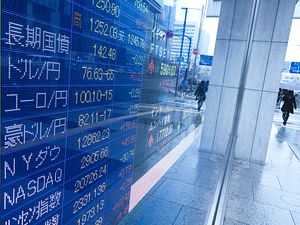Weak economic data from China and Japan has pointed toward a softer outlook for 2014. Is it time to hit the panic button?
On Wednesday, China’s central bank took the trouble of releasing a lengthy explanatory statement after a sharp fall in lending growth surprised markets. Aggregate financing, including direct financing, new loans, and off-balance sheet lending dived to 273 billion yuan (about $44 billion) in July, barely a fifth of market expectations of 1.5 trillion yuan, and well down on June’s 1.97 trillion yuan.
New yuan loans plunged to 385 billion yuan from 1 trillion yuan the prior month, well below market forecasts of 780 billion yuan. A softening in trust and entrusted loan growth also indicated a slowdown in shadow banking activities, with negative implications for the property sector, ANZ Research said.
Such a drop in lending has only occurred twice before in recent times, after the 2008 “Lehman shock” and in the wake the September 2001 terrorist attacks on the United States, according to ANZ, which warned that the data “should not be viewed lightly.”
“It means that the financial system is engaging [in] a rapid de-leveraging process, which could have significant repercussions on the real economy. Such a sharp drop in credit is in fact a quantitative tightening, which will lead to high interest rates and endanger China’s macroeconomic objective,” ANZ said.
“Although the [central bank] has been always reluctant to ease, China’s macroeconomic objective will eventually outweigh the current monetary policy inertia. We believe a [reserve requirement] cut is imminent in order to restore confidence,” ANZ China’s economists added.
The People’s Bank of China shrugged off the weak data, saying July was typically a slow month and pointing to improved lending for August.
However, Credit Suisse’s China economist Dong Tao was less impressed, telling the Australian Financial Review “the number was horrible.”
“Banks are choosing not to lend as the economy is weak and the housing sector is sick,” he said.
Factory output, fixed asset investment and retail sales figures for July also disappointed, the financial daily noted. Housing sales have dropped 8 percent for the first seven months of 2014, compared to last year’s near 38 percent gain.
Nevertheless, Chinese stocks ended higher Wednesday on speculation that Beijing would take action to support its 7.5 percent GDP growth target. Barclays has forecast two interest rate cuts in the second half of 2014, while official sources have suggested a “lean toward relaxation.”
“The softer July activity and credit data suggests that mini-stimulus measures will remain in place,” AMP Capital Investors’ Shane Oliver told Bloomberg News. “We may even see more growth-boosting measures in the months ahead.”
Japan’s Growth Reversal
Meanwhile, Japan announced Wednesday an annualized 6.8 percent GDP contraction in the June quarter, its worst slump since the March 2011 disasters, as April’s consumption tax hike weighed on spending. Although better than market expectations for a 7 percent decline, the fall was in stark contrast to the 6.1 percent expansion seen in the first quarter.
Household consumption dived by an annualized 19.2 percent from the previous quarter, while private investment dipped nearly 10 percent, as consumers and businesses held back on spending following the three percentage point increase in the sales tax to 8 percent.
Despite a weaker yen, exports dropped by 1.8 percent and imports slumped by 20 percent, reflecting softer growth in Japan’s major trading partners.
“The only apparent bright spot in today’s data was that net trade added to growth for the first time since the launch of Abenomics,” Capital Economics’ Marcel Thieliant was quoted saying by Bloomberg News. “Unfortunately, this was mostly due to a collapse in import volumes as a result of weaker domestic demand, while exports showed a renewed decline.”
Yet according to a Bloomberg survey, the world’s third-biggest economy is expected to post an annualized GDP gain of 2.9 percent in the third quarter. This would provide sufficient grounds for Prime Minister Shinzo Abe to approve next year’s planned increase in the sales tax to 10 percent, according to analysts.
In more positive news for Abenomics’ war on deflation, the GDP deflator increased 2 percent from a year earlier, posting its first rise in 19 quarters on the back of the higher sales tax, rising materials and labor costs.
“Price increases are spreading,” SMBC Nikko Securities economist Koya Miyamae told Bloomberg News. “It’s highly likely the government will declare Japan is out of deflation this year before making a decision on the next sales-tax hike.”
Other economists also expressed optimism that Abenomics remained on track to achieve its targets.
“We believe real GDP will return to growth exceeding potential [next quarter],” Barclays economists Kyohei Morita and Yuichiro Nagai were quoted saying by AP. They pointed to improvements in leading economic indicators for public works and housing construction as evidence for their bullishness.
The International Monetary Fund expects Japan to post a 1.6 percent expansion in 2014, slowing to 1.1 percent next year, while China is forecast to see growth cool from 7.4 percent this year to 7.1 percent in 2015.
Yet as noted by Pacific Money, the Fund’s economists have urged China to slow its economy toward a more sustainable “new growth model,” while neighboring Japan has been told to fire up promised structural reforms.
“So far, Abenomics has meant lots of stimulus and no deregulation, a recipe that has boosted inflation more than growth or confidence,” Bloomberg columnist William Pesek said.
For China and Japan, there appears little scope for “summertime relaxing” while their economies shiver.

































